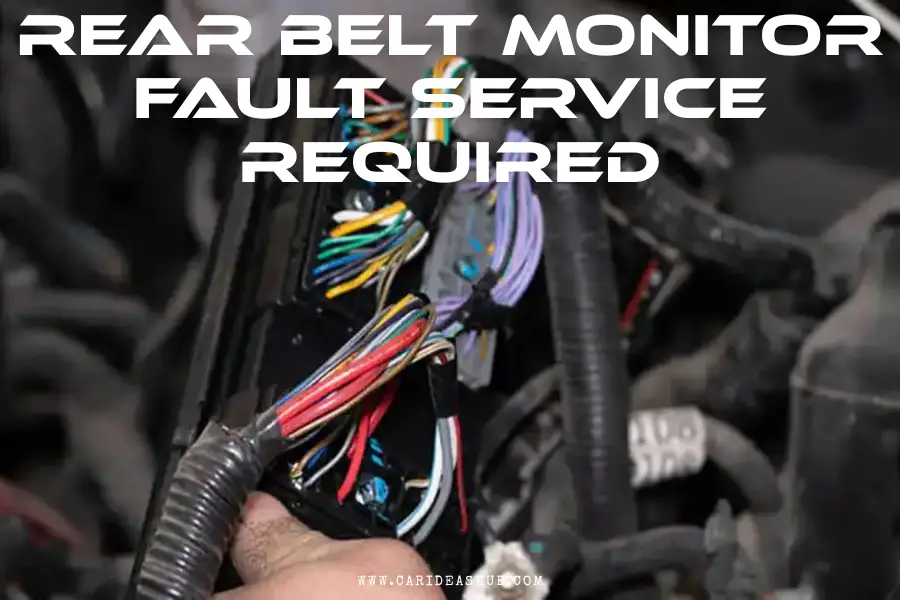A “Rear Belt Monitor Fault – Service Required” message indicates a malfunction in the rear seatbelt system. Promptly consult a certified technician to ensure passenger safety and system integrity.
Your vehicle’s safety features are paramount, and a functioning rear belt monitoring system is essential for passenger protection. This alert typically surfaces when the sensors that detect whether passengers have fastened their seat belts are not operating correctly. It’s crucial to address this immediately as it involves the safety mechanisms of your car.
Ignoring such warnings can lead to compromised passenger safety and potential legal issues, as seat belt use is mandatory in many regions. To maintain your vehicle’s safety standards and ensure a smooth driving experience, it’s advisable to schedule a diagnostic with a professional. Resolving rear belt monitor faults swiftly helps preserve the vehicle’s value and keeps safety features operational. Contact your local dealership or an authorized repair shop to address any seat belt system issues promptly.
Rear Belt Monitor Fault Explained
The rear belt monitor is an essential safety feature in modern vehicles, designed to alert drivers when seat belts in the rear seats are not fastened. A fault in this system compromises not only the vehicle’s safety integrity but also could be a sign of underlying issues. Understanding the causes of rear belt monitor faults, the impact on vehicle safety, and the indicators to watch out for helps drivers maintain their vehicle’s safety features and take swift action when necessary.
Causes Of Rear Belt Monitor Faults
Several factors can contribute to a rear belt monitor fault, and diagnosing the precise cause is crucial in addressing the issue effectively. Common causes include:
- Wiring issues: Frayed or broken wires can disrupt the signal, causing a fault in the system.
- Sensor malfunction: If the sensors that detect whether the belts are fastened fail, the monitor will not function properly.
- Seat belt buckles problems: Damaged or jammed buckles may not register as engaged, even when they are.
- Control unit failure: The central unit analyzing seat belt status may experience a fault, leading to incorrect readings.
Impact On Vehicle Safety
Vehicle safety can be significantly compromised when a rear belt monitor fault occurs. The role of the rear belt monitor is to:
- Keep the driver informed about the status of rear seat belts.
- Ensure that all passengers comply with safety regulations.
- Activate additional safety measures in case of sudden stops or accidents when seat belts are fastened.
Without a functioning monitor, drivers may be unaware of unbuckled passengers, increasing the risk of injury during an accident. Moreover, certain car features such as airbag deployment may rely on seat belt tension to calibrate their response.
Indicators And Warnings For Drivers
Being able to identify when a rear belt monitor fault occurs is critical. The vehicle’s system provides specific indicators and warnings to alert the driver, including:
- A warning light or symbol on the dashboard, typically accompanied by an audible chime.
- Messages on the multi-information display (if available), indicating the precise nature of the fault.
- Intermittent or persistent warnings that do not clear even after all rear seat belts are fastened securely.
Drivers should take any indication of a rear belt monitor fault seriously and seek immediate diagnostic and repair services to restore the system’s functionality and maintain optimal safety for all vehicle occupants.
Diagnosing Your Belt Monitor Issue
Encountering a ‘Rear Belt Monitor Fault Service Required’ message on your vehicle’s dashboard can be unsettling. This warning indicates that there’s a malfunction within the system responsible for ensuring passenger safety through seat belt monitoring. Diagnosing this issue properly is critical to maintain the safety standards of your vehicle. Embarking on this diagnostic journey requires a step-by-step approach to identify the root problem, a set of specific tools, and a keen awareness of common diagnostic mistakes to avoid.
Steps To Identify The Root Problem
Accurately diagnosing a rear belt monitor fault begins with a systematic approach:
- Verify the Fault Message: Ensure the message is consistent and not a sporadic glitch.
- Manual Check: Inspect the rear seat belts for any visible signs of wear, damage, or malfunction.
- Sensor Testing: Assess the integrity of the seat belt sensors and wiring, paying special attention to any signs of damage or disconnection.
- Error Codes: Use a diagnostic scan tool to read any fault codes stored in the vehicle’s computer system.
- Consult the Manufacturer’s Guidelines: Refer to your vehicle’s specific service manual for troubleshooting procedures related to the belt monitor system.
Tools Needed For Diagnosis
To effectively diagnose a belt monitor issue, certain tools are essential:
- Diagnostic Scan Tool: A device required to read and interpret the vehicle’s diagnostic codes.
- Multimeter: For electrical testing of sensors and wiring to pinpoint malfunctions.
- Service Manual: Your vehicle’s comprehensive guide containing crucial information for troubleshooting.
- Visual Inspection Tools: A flashlight or inspection camera to check hard-to-see areas.
Common Diagnostic Mistake To Avoid
One frequent misstep during the diagnostic process is overlooking the vehicle’s history and recent incidents. An oversight such as ignoring:
- Past Repairs: Neglecting previous electrical or seat belt system repairs, which may be relevant to the current issue.
- Recent Vehicle Changes: Failing to consider recent modifications, accidents, or significant events that could affect the belt monitoring system.
This could lead to an incorrect diagnosis, making it crucial to approach the task with an inclusive perspective by accounting for all relevant vehicle history.
Quick Fix Guide For Belt Monitor
Welcome to the Quick Fix Guide for Rear Belt Monitor Faults! When that dreaded message pops up on your dash, it can be a source of frustration. But fear not, this comprehensive guide aims to alleviate your worries with simple fixes you can do all by yourself. Whether you’re on your way to work or about to take a road trip, these straightforward solutions will help you tackle that belt monitor error and get back to your journey safely and swiftly.
Precautionary Measures Before Attempting Fixes
- Consult your vehicle’s manual: Always check the manufacturer’s instructions — safety first!
- Turn off the engine: Avoid any electrical mishaps or other safety concerns.
- Use protective gear: Equip yourself with gloves and eyewear if applicable.
- Identify the belt monitor system: Locate the correct component to ensure proper handling.
Temporary Solutions For Immediate Relief
- Reset the system: Sometimes, a simple restart of the vehicle can clear transient errors.
- Check the belts: Ensure that all passenger seat belts are securely fastened.
- Inspect for obstructions: Remove any objects that might be blocking sensors or belt buckles.
- Manual override: Some vehicles have a specific procedure to bypass the warning temporarily. Consult your manual for details.
Professional Versus Diy Repair Approaches
Deciding between DIY and professional help really depends on your comfort level with vehicle maintenance and diagnostics. Let’s break it down:
| DIY Repair | Professional Repair |
|---|---|
| Cost-effectivePersonal satisfactionLearning opportunity | Expert knowledgeGuaranteed fixTime-saving |
When tackling a DIY fix, ensure you have the right tools and perhaps a guided video tutorial at hand. Meanwhile, a professional mechanic can quickly diagnose and resolve complex issues rooted deeply in the car’s safety system, sparing you the hassle and ensuring a job well done.
Troubleshooting Common Belt Monitor Faults
Encountering a “Rear Belt Monitor Fault Service Required” message can be both confusing and alarming for vehicle owners. Understanding how to approach and resolve such issues is vital for ensuring passenger safety and maintaining the integrity of your vehicle’s safety systems. Let’s dive into troubleshooting common belt monitor faults and get you back on the road with confidence.
Addressing False Alarms In The System
False alarms in rear belt monitoring systems often stem from sensor misinterpretation or software glitches. To address these false alarms, start by:
- Inspecting the seat belts for any visible damage or obstruction that could interfere with the sensor.
- Ensuring that the seat belt buckles are properly engaged and not mistakenly released.
- Cleaning the sensor areas to eliminate any dust or debris that might trigger incorrect readings.
Once a thorough check is carried out and the potential causes are eliminated, the false alarms should cease. If problems persist, further assessment may be needed to diagnose the underlying issue.
Resetting The Rear Belt Monitor
If the belt monitor continues to indicate a fault after false triggers have been ruled out, a system reset may be necessary. Resetting can often resolve minor electronic glitches. Follow these steps to reset your rear belt monitor:
- Turn the engine off and remove the key from the ignition.
- Wait for at least one minute to allow the vehicle’s electrical system to fully power down.
- Reinsert the key and start the vehicle again to initiate the reset process.
Note that procedures for resetting the belt monitor may vary depending on the vehicle make and model, so refer to the owner’s manual for specific instructions.
Replacing Faulty Sensors Or Components
In instances where resetting the monitor doesn’t resolve the issue, it’s possible that a sensor or another component in the system may be faulty. Replacing these defective parts is crucial for the proper functioning of the belt monitor. A few indicators of sensor or component failure include:
| Indicator | Possible Cause |
|---|---|
| Constant fault alert | Faulty sensor |
| Intermittent alerts | Loose wiring or connections |
| No response from the system | Broken belt buckle or sensor |
If you suspect a component failure, seek professional assistance to diagnose and replace the faulty parts. Specialized diagnostic tools can pinpoint the exact cause and save time in the repair process.
Maintaining Your Rear Belt Monitor System
The importance of maintaining the rear belt monitor system in your vehicle cannot be understated. This critical safety feature keeps track of whether the passengers in the back seat have their seatbelts fastened, which is especially vital for ensuring the safety of younger occupants. Neglecting this system can lead to a ‘Rear Belt Monitor Fault Service Required’ error, which is why it’s essential to perform regular checks and maintenance to prevent malfunctions.
Regular Checks And Preventative Maintenance
Consistent monitoring and preventative care are key in avoiding unexpected errors with your rear belt monitor system. Here’s how to approach it:
- Visual inspection: Periodically check the condition of the rear seat belts. Look for signs of wear, fraying, or damage that could affect functionality.
- Cleanliness: Keep the belt and buckle areas clean. Debris can interfere with the sensors, causing false readings or malfunctions.
- Test the system: Regularly test the rear belt monitor by buckling and unbuckling the belts to ensure the system accurately detects the status.
- Evaluation after impact: Service your rear belt monitor system immediately if your vehicle has been involved in a collision, regardless of severity.
Upgrading The Rear Belt Monitor System
Advancements in vehicle safety technology mean that upgrading your rear belt monitor can add layers of protection. Consider these options:
| Upgrade | Benefits |
|---|---|
| Advanced sensors | Provides more accurate readings, minimizes false alarms |
| Integration with infotainment | Displays real-time belt status for driver awareness |
| Automatic notifications | Sends alerts when a belt is unbuckled during transit |
When To Consult A Professional Mechanic
Maintaining the rear belt monitor system DIY-style works up to a point. Recognize when it’s time to seek a professional’s expertise. Look out for these indicators:
- Persistent warning messages or dashboard lights despite troubleshooting.
- Odd sounds or responses when engaging the rear seatbelts.
- After a vehicle accident, even if no damage to the belt system is visible.
Entrusting your vehicle to a licensed mechanic ensures proper diagnosis, repair, or replacement of the rear belt monitor system, assuring safety for all passengers.

Credit: feeco.com
Frequently Asked Questions Of Rear Belt Monitor Fault Service Required
What Is A Rear Belt Monitor Fault?
A rear belt monitor fault indicates a malfunction in the system monitoring rear seat belts. It can signal a sensor issue or circuit problem, potentially affecting passenger safety.
How Can I Fix A Rear Belt Monitor Fault?
To fix a rear belt monitor fault, first, check for loose connectors or damaged wiring. If no issues are found, a professional diagnostic test may be necessary to pinpoint the exact malfunction.
Does A Rear Belt Monitor Fault Affect Car Safety?
Yes, a rear belt monitor fault can affect car safety by impairing the system’s ability to notify when rear seat belts are not properly fastened, potentially increasing injury risk in an accident.
Is Rear Belt Monitor Fault Service Expensive?
The cost to service a rear belt monitor fault can vary. It depends on the extent of the issue and the vehicle model. Typically, diagnostics and sensor replacement can range from moderate to high cost.
Conclusion
To sum up, addressing a rear belt monitor fault promptly is vital for passenger safety and vehicle functionality. Regular maintenance can prevent this issue. Should the service required light illuminate, consult a professional mechanic. Tackle the problem early to ensure a secure and comfortable driving experience for everyone on board.

